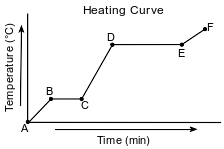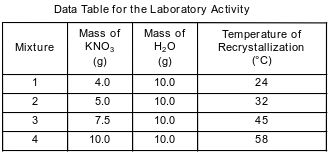Topic: Physical Change And Chemical Change
Physical Change And Chemical Change
Given the key:

Which particle model diagram represents a chemical change?
(1) 
(2) ![]()
(3) ![]()
(4) 
When a sample of CO2(s) becomes CO2(g), there is a change in
(1) bond type
(2) gram-formula mass
(3) molecular polarity
(4) particle arrangement
Which process is a chemical change?
(1) evaporating an alcohol
(2) subliming of iodine
(3) melting an ice cube
(4) rusting of iron
Which change is most likely to occur when a molecule of H2 and a molecule of I2 collide with proper orientation and sufficient energy?
(1) a chemical change, because a compound is formed
(2) a chemical change, because an element is formed
(3) a physical change, because a compound is formed
(4) a physical change, because an element is formed
Which processes represent one chemical change and one physical change?
(1) freezing and melting
(2) freezing and vaporization
(3) decomposition and melting
(4) decomposition and combustion
Which change results in the formation of different substances?
(1) burning of propane
(2) melting of NaCl(s)
(3) deposition of CO2(g)
(4) solidification of water
Which statement describes a chemical change?
(1) Alcohol evaporates.
(2) Water vapor forms snowflakes.
(3) Table salt (NaCl) is crushed into powder.
(4) Glucose (C6H12O6) and oxygen produce CO2 and H2O.
Based on Table I, which compound dissolves in water by an exothermic process?
(1) NaCl
(2) NaOH
(3) NH4Cl
(4) NH4NO3
During which two processes does a substance release energy?
(1) freezing and condensation
(2) freezing and melting
(3) evaporation and condensation
(4) evaporation and melting
Starting as a solid, a sample of a molecular substance is heated, until the entire sample of the substance is a gas. The graph below represents the relationship between the temperature of the sample and the elapsed time.

State evidence that indicates the sample undergoes only physical changes during this heating.
Allow 1 credit. Acceptable responses include, but are not limited to:
• No new substance is formed.
• The phase changes do not change the chemical properties of the substance.
Wood is mainly cellulose, a polymer produced by plants. One use of wood is as a fuel in campfires, fireplaces, and wood furnaces. The molecules of cellulose are long chains of repeating units. Each unit of the chain can be represented as C6H10O5. The balanced equation below represents a reaction that occurs when C6H10O5 is burned in air.
C6H10O5 + 6O2 → 6CO2 + 5H2O + heat
Explain, in terms of substances in the reaction, why the equation represents a chemical change.
Allow 1 credit. Acceptable responses include, but are not limited to:
• The products of the reaction are different substances than the reactants.
• The chemical properties of the reactants and the products are different.
• Bonds are broken in the reactants and new bonds are formed in the products.
• Different substances are formed.
The reaction between aluminum and an aqueous solution of copper(II) sulfate is represented by the unbalanced equation below.
Al(s) + CuSO4(aq) → Al2(SO4)3(aq) + Cu(s)
Explain why the equation represents a chemical change.
Allow 1 credit. Acceptable responses include, but are not limited to:
• The products are different substances with different properties from the reactants.
• There is a loss and gain of electrons by substances in the reaction.
In a laboratory activity, each of four different masses of KNO3(s) is placed in a separate test tube that contains 10.0 grams of H2O at 25°C.
When each sample is first placed in the water, the temperature of the mixture decreases. The mixture in each test tube is then stirred while it is heated in a hot water bath until all of the KNO3(s) is dissolved. The contents of each test tube are then cooled to the temperature at which KNO3 crystals first reappear. The procedure is repeated until the recrystallization temperatures for each mixture are consistent, as shown in the table below.

Based on Table I, explain why there is a decrease in temperature when the KNO3(s) was first dissolved in the water.
Allow 1 credit. Acceptable responses include, but are not limited to:
• The solution would decrease in temperature because the dissolving of KNO3(s) is endothermic.
• The heat of solution is positive, which means the mixture would decrease in temperature.
• The ∆H is + 34.89 kJ, so KNO3(s) requires energy to dissolve.
Nitrogen dioxide, NO2, is a dark brown gas that is used to make nitric acid and to bleach flour. Nitrogen dioxide has a boiling point of 294 K at 101.3 kPa. In a rigid cylinder with a movable piston, nitrogen dioxide can be in equilibrium with colorless dinitrogen tetroxide, N2O4. This equilibrium is represented by the equation below.
2NO2(g) ⇌ N2O4(g) + 58 kJ
State evidence from the equation that the forward reaction is exothermic.
Allow 1 credit. Acceptable responses include, but are not limited to:
• There are 58 kJ of energy produced by the forward reaction.
• The heat term is on the right side of the equation.
During photosynthesis, plants use carbon dioxide, water, and light energy to produce glucose, C6H12O6, and oxygen. The reaction for photosynthesis is represented by the balanced equation below.
6CO2 + 6H2O + light energy → C6H12O6 + 6O2
State evidence that indicates photosynthesis is an endothermic reaction.
Allow 1 credit. Acceptable responses include, but are not limited to:
• Photosynthesis is an endothermic reaction because light energy is absorbed.
• The energy term is on the left side of equation.
• ΔH is positive.
• The reaction requires light.
